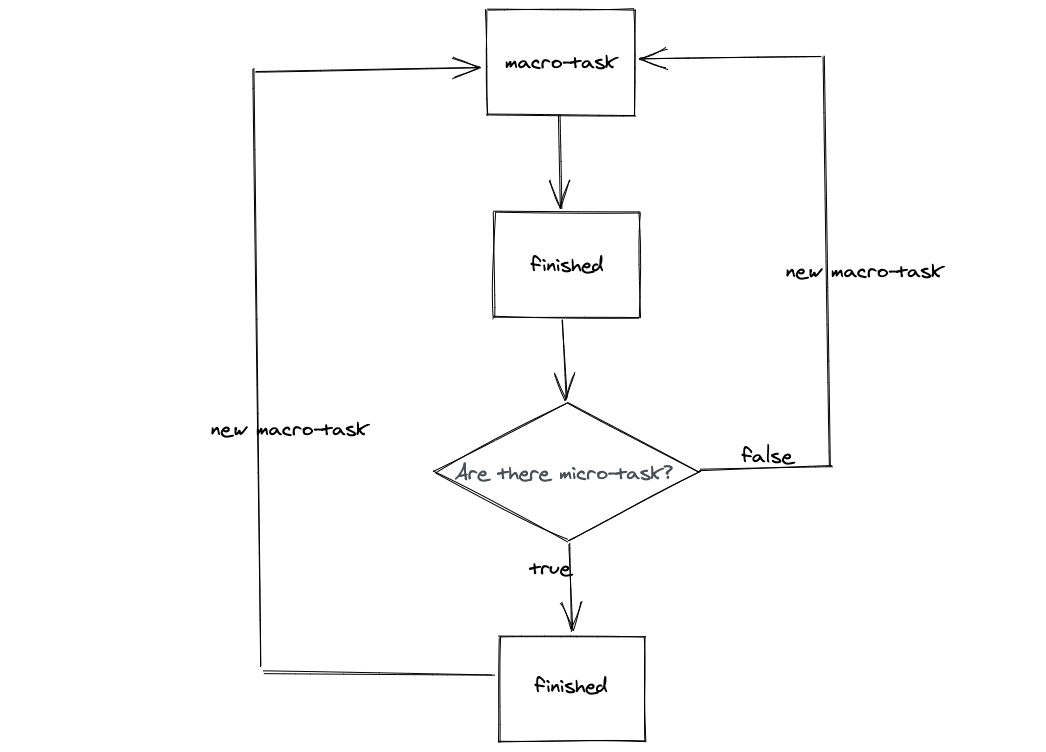写在前面
入行前端已两年有余了。之前我在一篇文章中写了——要明白前端领域的变与不变。现在和两年前一样,各种框架层出不穷,让人眼花缭乱。很多时候我也在问自己『这个还需要学吗』。这样很容易让我产生焦虑感。而且在面对新事物时,我经常会感到手足无措。归根结底还是基础知识不扎实,内功不够。这也是我写这篇文章的目的——提升内功,更好的理解『变与不变』。
要开始了
先从这段代码开始探索之旅吧
console.log('开始了')
// setTimeout1
setTimeout(function () {
console.log('timeout1')
// promise1
new Promise(function (resolve) {
console.log('timeout1_promise')
resolve()
}).then(function () {
console.log('timeout1_then')
})
}, 2000)
for (var i = 1; i <= 5; i++) {
// setTimeout2
setTimeout(function () {
console.log(i)
}, i * 1000)
console.log(i)
}
// promise2
new Promise(function (resolve) {
console.log('promise1')
resolve()
}).then(function () {
console.log('then1')
})
// setTimeout3
setTimeout(function () {
console.log('timeout2')
// promise3
new Promise(function (resolve) {
console.log('timeout2_promise')
resolve()
}).then(function () {
console.log('timeout2_then')
})
}, 1000)
// promise4
new Promise(function (resolve) {
console.log('promise2')
resolve()
}).then(function () {
console.log('then2')
})
开始之前,喜欢思考问题的小伙伴可能会有两个问题。javascript为什么被设计为单线程语言,为什么又会有同步任务和异步任务的区分。这两个问题,在这里我就不细述了。感兴趣的同学请看阮老师的这篇文章。
现在我们来看一下js大致是怎么执行的。

到底哪些是宏任务,哪些是微任务呢。大体上这样区分。
宏任务(macro-task)
- script(整体JavaScript代码)
- setTimeout()
- setInterval()
- setImmediate()
- I/O
- UI render
微任务(micro-task)
- promise
- async/await(同☝)
- process.nextTick
- MutationObserver
预备知识已经准备的差不多了,现在我们开始执行上面那段代码。
- 首先整体script进入主线程,遇到
console.log(),立即输出『开始了』 - 接下来遇到
setTimeout,2s后回调函数function()被分发到宏任务Event Queue中(注意这里不是2s后执行),这里标记为setTimeout1 - 遇到
for,直接执行,同理setTimeout中的回调函数被分发到宏任务Event Queue中(这里涉及到闭包的知识),标记为setTimeout2,然后执行console.log,输出『1,2,3,4,5』 - 遇到
promise,new Promise直接执行,输出『promise1』。then被分发到微任务Event Queue中,标记为then1 - 接下来又遇到了一个
setTimeout,1s后回调函数function()被分发到宏任务Event Queue中,标记为setTimeout3 - 又遇到
promise,同理,输出『promise2』,then被分发到微任务Event Queue中,标记为then2
第一轮事件循环的宏任务已经执行完毕。Event Queue中的任务如下表所示
| 宏任务 | 微任务 |
|---|---|
| setTimeout1(2s later) | then1 |
| setTimeout2(1s later) | then2 |
| setTimeout3(1s later) |
根据上面的流程图,宏任务执行完后,js引擎的监视进程会检查此时有没有可以执行的微任务。这时后分发到微任务Event Queue的then将被执行。依次输出『then1』,『then2』
第一轮事件循环全部执行完毕。
好了,现在开始第二轮事件循环(1s后)。
- 遇到
setTimeout2,输出『6』,没有可以执行的微任务。执行新的宏任务。 - 遇到
setTimeout3,输出『timout2』,new promise立即执行,输出『timeout2_promise』,then被分发到微任务Event Queue中。标记为then3
第二轮事件循环的宏任务执行完毕。Event Queue中的任务如下表所示
| 宏任务 | 微任务 |
|---|---|
| setTimeout1(1s later) | then3 |
| setTimeout2(1s later) |
同理,宏任务执行完后。执行此轮的微任务then3。
第二轮事件循环全部执行完毕。
- 遇到
setTimeout1,执行console.log,输出『timeout1』,new promise立即执行,输出『timeout1_promise』,then被分发到微任务Event Queue中。标记为then4 - 第三轮事件循环宏任务执行完毕,执行此轮的微任务
then,输出『timeout1_then』
第三轮事件循环执行完毕。
setTimeout2中依次会产生4个宏任务,每隔1s输出一个6
至此,整段代码全部执行结束。
总结:宏任务执行完了,执行该宏任务产生的微任务。如果微任务在执行过程中产生新的微任务,则继续执行微任务。微任务执行完毕后,回到宏任务中开始下一轮循环。
async
node
参考资料
Drag and drop your files here
Loading comments...